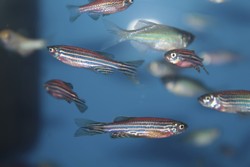How vertebrates move
Movement in vertebrates relies on nerve cells or neurons that connect with each other to form complex circuits. One of these networks, called central pattern generators (CPGs), originates from the spinal cord and controls rhythmic movements. For example, by causing muscles to alternately contract and relax, CPGs allow zebrafish larvae to swim forward. Based on previous research, the EU-funded OPTO-LOCO (Unraveling the circuits of locomotion with opto-genetic manipulation of neuronal activity in awake behaving animals) initiative studied the neural circuits of the spinal cord to better understand how vertebrates move. Researchers focused on cells at the interface between the spinal cord and the central canal, called cerebrospinal fluid-contacting neurons (CSF-cNs). They suspected that the spinal cord integrates sensory information not only from the brain and the outside world but also from the body's internal environment. This theory developed from observing that both movement and posture are affected by inner body states like blood pressure, pH and oxygen concentration. To reveal more about what CSF-cNs do, scientists used a technique called optogenetics, which uses light to control the activity of neurons. By turning on and off selected neurons over time, the team could determine which neuron must be fired to generate a particular movement. The scientists discovered that movements such as the slow forward swim of larval zebrafish are controlled by CSF-cNs in concert with CPGs. Movement coordination required special sensors called proprioceptors, which provide information on muscle length and tension to give a sense of a limb's position in space. In an exciting development, the team also confirmed that CSF-cNs detect bending of the spine and control posture. By revealing a new sensory pathway in the spinal cord, OPTO-LOCO results may help efforts to recover function in injured spinal cords.
Keywords
Vertebrates, spinal cord, central pattern generators, OPTO-LOCO, cerebrospinal fluid-contacting neurons

